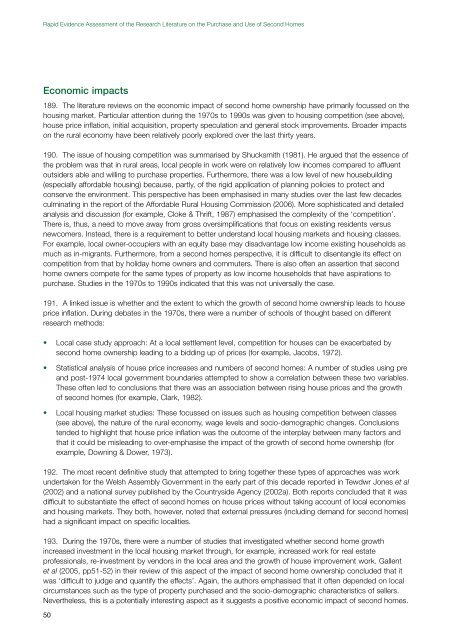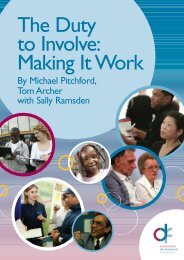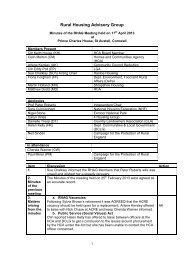Rapid Evidence Assessment of the Research ... - Rural Housing
Rapid Evidence Assessment of the Research ... - Rural Housing
Rapid Evidence Assessment of the Research ... - Rural Housing
You also want an ePaper? Increase the reach of your titles
YUMPU automatically turns print PDFs into web optimized ePapers that Google loves.
<strong>Rapid</strong> <strong>Evidence</strong> <strong>Assessment</strong> <strong>of</strong> <strong>the</strong> <strong>Research</strong> Literature on <strong>the</strong> Purchase and Use <strong>of</strong> Second Homes<br />
Economic impacts<br />
189. The literature reviews on <strong>the</strong> economic impact <strong>of</strong> second home ownership have primarily focussed on <strong>the</strong><br />
housing market. Particular attention during <strong>the</strong> 1970s to 1990s was given to housing competition (see above),<br />
house price inflation, initial acquisition, property speculation and general stock improvements. Broader impacts<br />
on <strong>the</strong> rural economy have been relatively poorly explored over <strong>the</strong> last thirty years.<br />
190. The issue <strong>of</strong> housing competition was summarised by Shucksmith (1981). He argued that <strong>the</strong> essence <strong>of</strong><br />
<strong>the</strong> problem was that in rural areas, local people in work were on relatively low incomes compared to affluent<br />
outsiders able and willing to purchase properties. Fur<strong>the</strong>rmore, <strong>the</strong>re was a low level <strong>of</strong> new housebuilding<br />
(especially affordable housing) because, partly, <strong>of</strong> <strong>the</strong> rigid application <strong>of</strong> planning policies to protect and<br />
conserve <strong>the</strong> environment. This perspective has been emphasised in many studies over <strong>the</strong> last few decades<br />
culminating in <strong>the</strong> report <strong>of</strong> <strong>the</strong> Affordable <strong>Rural</strong> <strong>Housing</strong> Commission (2006). More sophisticated and detailed<br />
analysis and discussion (for example, Cloke & Thrift, 1987) emphasised <strong>the</strong> complexity <strong>of</strong> <strong>the</strong> ‘competition’.<br />
There is, thus, a need to move away from gross oversimplifications that focus on existing residents versus<br />
newcomers. Instead, <strong>the</strong>re is a requirement to better understand local housing markets and housing classes.<br />
For example, local owner-occupiers with an equity base may disadvantage low income existing households as<br />
much as in-migrants. Fur<strong>the</strong>rmore, from a second homes perspective, it is difficult to disentangle its effect on<br />
competition from that by holiday home owners and commuters. There is also <strong>of</strong>ten an assertion that second<br />
home owners compete for <strong>the</strong> same types <strong>of</strong> property as low income households that have aspirations to<br />
purchase. Studies in <strong>the</strong> 1970s to 1990s indicated that this was not universally <strong>the</strong> case.<br />
191. A linked issue is whe<strong>the</strong>r and <strong>the</strong> extent to which <strong>the</strong> growth <strong>of</strong> second home ownership leads to house<br />
price inflation. During debates in <strong>the</strong> 1970s, <strong>the</strong>re were a number <strong>of</strong> schools <strong>of</strong> thought based on different<br />
research methods:<br />
• Local case study approach: At a local settlement level, competition for houses can be exacerbated by<br />
second home ownership leading to a bidding up <strong>of</strong> prices (for example, Jacobs, 1972).<br />
• Statistical analysis <strong>of</strong> house price increases and numbers <strong>of</strong> second homes: A number <strong>of</strong> studies using pre<br />
and post-1974 local government boundaries attempted to show a correlation between <strong>the</strong>se two variables.<br />
These <strong>of</strong>ten led to conclusions that <strong>the</strong>re was an association between rising house prices and <strong>the</strong> growth<br />
<strong>of</strong> second homes (for example, Clark, 1982).<br />
• Local housing market studies: These focussed on issues such as housing competition between classes<br />
(see above), <strong>the</strong> nature <strong>of</strong> <strong>the</strong> rural economy, wage levels and socio-demographic changes. Conclusions<br />
tended to highlight that house price inflation was <strong>the</strong> outcome <strong>of</strong> <strong>the</strong> interplay between many factors and<br />
that it could be misleading to over-emphasise <strong>the</strong> impact <strong>of</strong> <strong>the</strong> growth <strong>of</strong> second home ownership (for<br />
example, Downing & Dower, 1973).<br />
192. The most recent definitive study that attempted to bring toge<strong>the</strong>r <strong>the</strong>se types <strong>of</strong> approaches was work<br />
undertaken for <strong>the</strong> Welsh Assembly Government in <strong>the</strong> early part <strong>of</strong> this decade reported in Tewdwr Jones et al<br />
(2002) and a national survey published by <strong>the</strong> Countryside Agency (2002a). Both reports concluded that it was<br />
difficult to substantiate <strong>the</strong> effect <strong>of</strong> second homes on house prices without taking account <strong>of</strong> local economies<br />
and housing markets. They both, however, noted that external pressures (including demand for second homes)<br />
had a significant impact on specific localities.<br />
193. During <strong>the</strong> 1970s, <strong>the</strong>re were a number <strong>of</strong> studies that investigated whe<strong>the</strong>r second home growth<br />
increased investment in <strong>the</strong> local housing market through, for example, increased work for real estate<br />
pr<strong>of</strong>essionals, re-investment by vendors in <strong>the</strong> local area and <strong>the</strong> growth <strong>of</strong> house improvement work. Gallent<br />
et al (2005, pp51-52) in <strong>the</strong>ir review <strong>of</strong> this aspect <strong>of</strong> <strong>the</strong> impact <strong>of</strong> second home ownership concluded that it<br />
was ‘difficult to judge and quantify <strong>the</strong> effects’. Again, <strong>the</strong> authors emphasised that it <strong>of</strong>ten depended on local<br />
circumstances such as <strong>the</strong> type <strong>of</strong> property purchased and <strong>the</strong> socio-demographic characteristics <strong>of</strong> sellers.<br />
Never<strong>the</strong>less, this is a potentially interesting aspect as it suggests a positive economic impact <strong>of</strong> second homes.<br />
50






